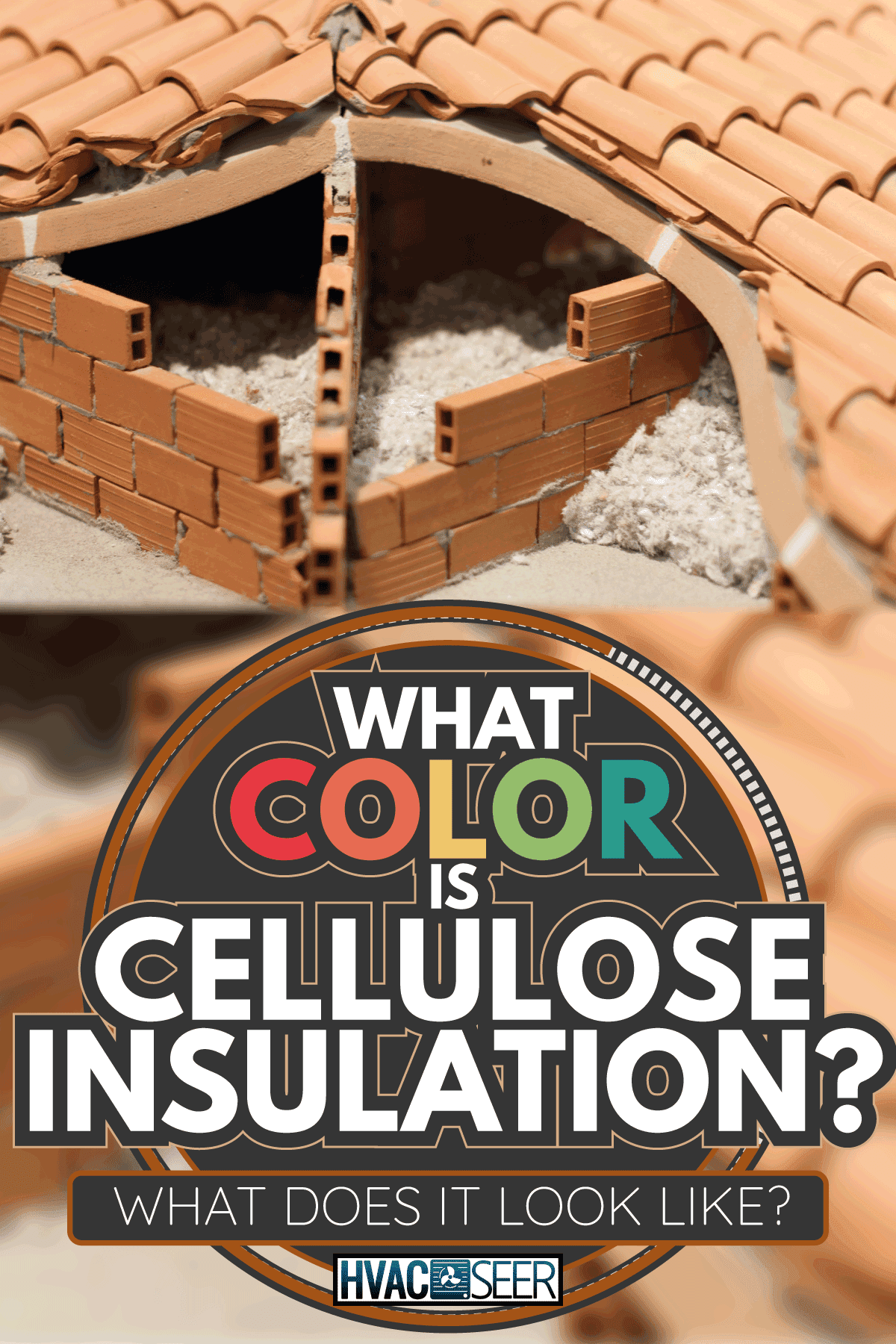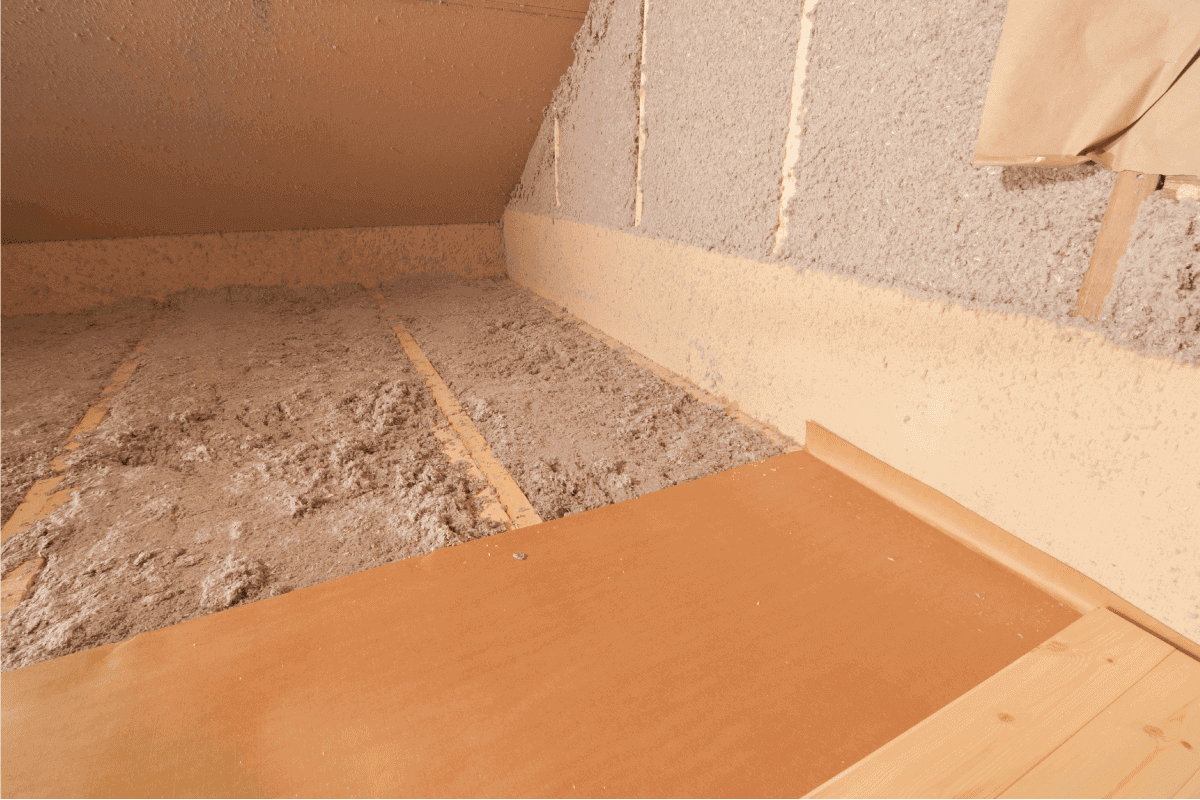Are you trying to figure out what kind of insulation is in your attic? Is cellulose colored or not? Does it look like piles of shredded paper or cotton candy? If you've been searching the internet for answers, look no further! We've done all the research for you right here.
Cellulose is light to medium gray, or an off-brown color. The color of cellulose insulation is always the same throughout your attic. It looks like piles of finely ground newspaper or fluffy down feathers.
Many people wonder what color cellulose insulation is, and what it looks like. If your attic insulation does not fit the above description, you may be wondering what insulation IS in your attic. Continue reading to find more details about the color and look of cellulose. We've included additional answers to the most frequently asked questions about this and other types of loose insulation.

The Color Of Cellulose Insulation And What It Looks Like
Cellulose insulation is made from finely ground paper. The color can range from light to medium gray, or even be an off-brown color. Cellulose looks just like fluffy mounds of downy feathers. It also resembles ground paper.
But don't be deceived, it's not for playing in, so don't allow children to jump in or play around it once it's installed. Disturbing it raises a huge amount of fine dust particles which can be irritating to the eyes, lungs, and skin.
In this photo below, you see cellulose insulation being installed in a brick building.
Does your insulation look different? Is the loose-fill in your attic a different color or texture? If so, your insulation might be fiberglass.
How Can You Tell Cellulose Insulation?
Cellulose is made from very finely ground paper, so it will look dull and fluffy. Cellulose is so fine that a slight touch, or even an air current, will cause the tiny particles to fly up into the air. If this happens, it's a good bet that you have cellulose.
If you're still not sure if you have cellulose insulation, get a flashlight and take a closer look. Shine the light across the insulation. Cellulose should not have any kind of sheen. If you see a shimmery quality, and especially if the insulation looks colored, it's probably fiberglass.
Fiberglass will look more like piles of shredded cotton candy. It's made from fine strands of glass held together with glue. If you move or touch it, particles will float in the air, just like cellulose. However, the particles from cellulose make a much bigger cloud. Both kinds of particles will be irritating to the eyes, lungs, and skin.

Does Cellulose Insulation Have A Smell?
Although it is generally odorless, if you have a keen sense of smell, you may detect a very slight, papery odor from cellulose insulation. Cellulose should not have any other detectable smell. Boric acid is added to cellulose to deter insects, prevent mold, and is fire-resistant, but there should be no smell.
If you smell something besides a slight paper odor from your cellulose insulation, chances are there is a problem somewhere.
Look for any discoloration of the material; it should all be the same color. Check for wet spots or disturbed areas where the fill looks uneven. These things could be a sign there is an air or water leak, or even animals may have entered and disturbed or damaged the insulation.
What's The Difference Between Pink And White Insulation?
If you've seen several colors of insulation, especially pink and white - or even yellow or green - the answer is that there is almost no difference except for the brand of the manufacturer. The color has nothing to do with the efficacy or R-value of your insulation. The color is added for visual appeal or is a result of the resin, glue, used to bind the fiberglass together.
Owen's Corning, trademark pink insulation. See it on Amazon.
Let's compare the MSDS, (Material Safety Data Sheet), for two popular blow-in, (loose-fill), fiberglass insulation products: Owen's Corning Pink Insulation and Johns Manville White Insulation.
- Owen's Corning, PINK, loose-fill insulation:
- Color - PINK
- Material - 90-100% Glass fiber/wool, and 0-5% petroleum distillates.
- R insulation value - An R13 value is achieved at a fill depth of about 6 six inches.
- R-value is the number that tells you how much the insulation will protect against outside climate; the higher the number, the more the insulation.
- Johns Manville, WHITE, loose-fill insulation:
- Color - WHITE
- Material - 98-100% non-bio persistent (bio-soluble) glass fiber.
- 'Non-biopersistent' means it won't stay in your lungs if accidentally inhaled it
- R insulation value - An R13 value is achieved at a fill depth of about 6 inches.
As you can see, there is not a lot of difference between pink and white insulation other than the color. Both types are made from micro-fibers of glass held together by resin. Both types deliver almost the same amount of insulation per inch. When it comes to sound-proofing, all fiberglass has a similar value as well.
The Difference Is Installation
The most important thing to know about the difference in insulation is that installation is the key. Proper installation determines how well your insulation will work. The color will make no difference.
To protect yourself, whatever color of insulation you choose, be sure to check how many bags of product your installer is using. Compare that against the installation guide for the product. All of the information can be found online on the manufacturer's website, and usually on the packaging as well.
The installation guide will tell you how many bags should be used per square feet of space to achieve the R-value you want. Measuring the depth of the loose insulation insures maximum efficiency.
Why Is Insulation Pink?
Not all insulation is pink, but pink insulation is exclusively manufactured by Owen's Corning. They actually have a trademark to produce insulation in the color pink. It has no effect on the insulation itself; it is simply a marketing tool.
There are other colors of insulation, it comes in yellow, green and white as well. Fiberglass is made from heated sand, which is processed into colorless, glass fibers. Resin is added to the glass fibers to give it substance. The color of the resin determines the color of the fiberglass insulation. Owen's Corning always uses pink resin.
Does The Color Of Insulation Mean Anything?
The color of insulation gives you a good idea of who made the insulation and the fabrication material. Cellulose is made from finely ground paper; it has a natural off-brown or light grayish color. The only additives are boric acid, which doesn't have any effect on the color.
Since fiberglass insulation is made from fine glass fibers, it is actually clear. To get those fibers to bind together, they use a type of glue called resin. The color of resin determines the final color of the insulation.
As we mentioned above, Owen's Corning owns the trademark for pink insulation, so almost all of their insulation is pink. Johns Manville manufactures a lot of their loose-fill and rolled fiberglass in white. Sometimes insulation is yellow or green. It all depends on the resin used.
The important thing to remember is that the final R-value is always determined by two things: the depth of the insulation and the type of insulation used. Whether you use cellulose or fiberglass, the color makes no difference in performance.

Does Insulation Change Color?
Insulation should not change color. Has your insulation changed or discolored? This could indicate a problem. If the insulation looks dark or even black in places, there might be a gap where air is being pulled or sucked through. When particles of dirt and moisture in the air get pulled into the insulation, it causes discoloration or blackening.
Luckily, because the insulation should be the same color all over the attic, any color changes can help you find air or moisture leaks. If you go up to your attic to see if there is a problem, be sure to wear protective equipment.
Use an air-filtering mask, protective eye goggles, long pants, and long-sleeved shirts. Although modern insulation is non-toxic, it is still very irritating to skin and eyes if inhaled.
These safety glasses seal around the edges to protect from suspended insulation particles. See them on Amazon.
In Summary
Now, you're practically an expert at identifying cellulose or even fiberglass insulation! And don't worry about the color, unless you really love pink.
For more information about insulation, see these articles:


